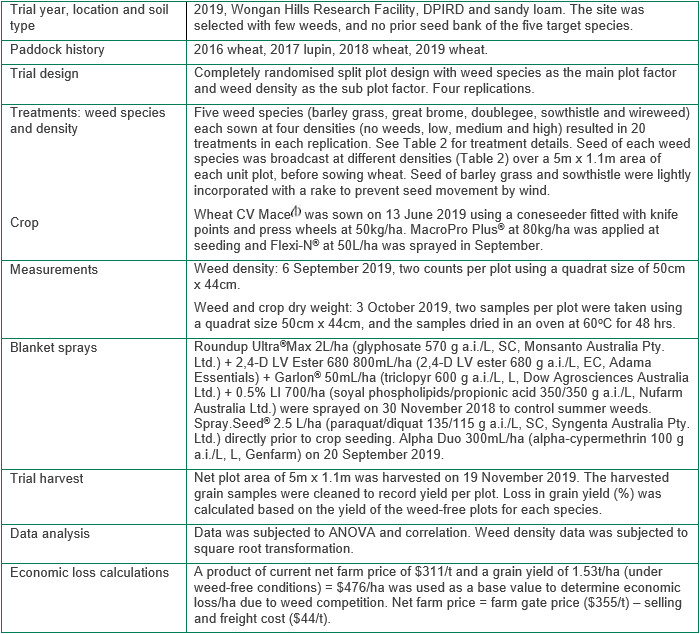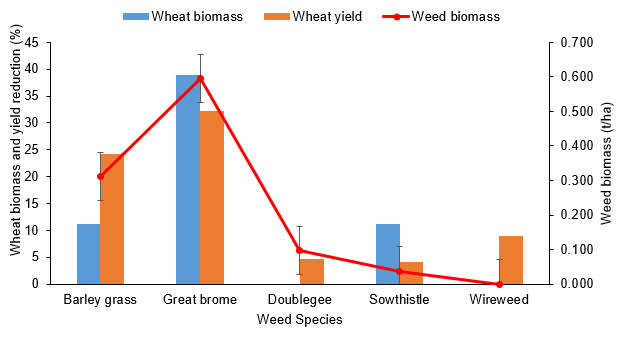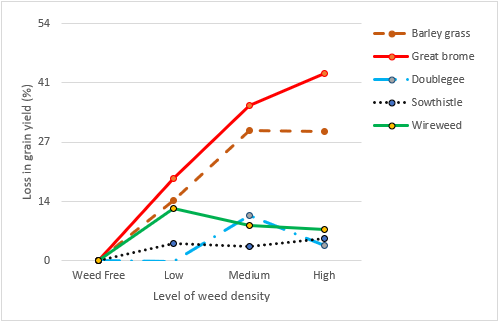Competitive ability of five weed species in wheat
Competitive ability of five weed species in wheat
Author: Harmohinder Dhammu, Abul Hashem, Catherine Borger, Glen Riethmuller, Nerys Wilkins and Pete Gray | Date: 01 Feb 2020
Key messages
- Great brome (Bromus diandrus) at a density of 140 plants/m2 reduced wheat grain yield by 43% and economic returns by $205/ha. Barley grass (Hordeum leporinum) at a density of 197 plants/m2 reduced wheat grain yield by 29% and economic returns by $138/ha.
- Doublegee (Rumex hypogaeus syn. Emex australis), sowthistle (Sonchus oleraceus) and wireweed (Polygonum aviculare) were comparatively less competitive and reduced wheat grain yield by up to 10%, 5% and 12%, with corresponding economic losses of $48, $24 and $57/ha, respectively.
- Management of these weed species early in the season is important to minimise grain yield loss.
Aims
The aim of this study was to determine the loss in wheat yield due to competition from five new emerging winter weed species in Western Australia. The extent of yield losses due to weeds depends on their density, time of emergence and species.
Introduction
Weeds compete with crops for resources including nutrients, water and light (Neito et al 2009). Competition from weeds is the most important of all biological factors that reduce agricultural crop yield (Gallandt and Weiner 2015). In Western Australia (WA), some minor weeds are now emerging as major weeds with greater infestation and frequency (Hashem et al 2017). Crop–weed competition studies can provide valuable information to growers and land managers on whether weed control is warranted (Swanton et al 2015). The extent of crop loss from five emerging weed species (barley grass, great brome, doublegee, sowthistle and wireweed) has not been investigated in intensive no-tillage cropping systems in WA. These weed species were identified as a research priority by GRDC’s Regional Cropping Solutions Network (RCSN) groups.
Method
Table 1. Agronomic details of the trial.

Results
Weed density
Emergence of weed species was low compared to the sown densities (Table 2). Barley grass recorded the highest plant establishment of 144 plants/m2 (averaged across densities), while wireweed had the lowest density of six plants/m2. Averaged over all species, density increased with increasing sowing rate (Table 2). The density of great brome and sowthistle increased significantly from zero to ‘high’ seeding density. For barley grass and doublegee, plant numbers increased significantly from a seeding density of zero to ‘medium’ density, but the increase was not statistically significant from ‘medium’ to ‘high’ seeding density (Table 2).
Table 2. The number of weed seeds sown per m2 in each treatment and the observed weed densities (‘weed free’ – ‘high’) per m2 in 2019 at Wongan Hills. Figures are back-transformed means from the ANOVA and figures in parenthesis are square root transformed values of weed densities. P-value for the weed species and density interaction was <0.001. LSD (0.05) was 1.86 to compare densities within a species and 2.17 for the species by density interaction.

Weed dry weight
Great brome grass recorded the highest dry weight of 0.6t/ha (averaged across densities), followed by barley grass (0.3t/ha), doublegee (0.096t/ha), sowthistle (0.038t/ha) and wireweed (0) (Figure 1). Even though barley grass had 47% more plant numbers/m2 than great brome, it had 48% less dry weight than great brome. However, ecotypes of barley grass are often smaller than great brome in WA. When these weeds were grown in controlled conditions at Northam, the seed-head height of barley grass ranged from 9 to 31cm, compared to 14 to 84cm for great brome plants (Borger and Hashem 2019). At the time of weed dry-weight sampling in October, wireweed was at the 3-8 leaf stage and its dry weight was less than 0.01t/ha across all densities. The correlation co-efficient between weed number and weed dry weight across species and densities was 0.74.
Wheat dry weight and grain yield
Great brome reduced wheat dry weight (sampled in October) by 39% compared to the weed-free treatment. Barley grass and sowthistle both reduced wheat biomass by 11% (Figure 1). Doublegee and wireweed did not reduce wheat dry weight. The interaction of wheat dry weight and weed density was not significant.
Great brome competition reduced wheat grain yield by 32% compared to the weed-free treatment. Yield reduction was 24% for barley grass, 9% for wireweed, 5% for doublegee and 4% for sowthistle (Figure 1).

Figure 1. Percent reduction in wheat dry weight and grain yield compared to the weed-free treatment and weed dry weight of different weed species at Wongan Hills Research Facility (averaged over weed density). Average wheat dry weight in weed-free plots was 2.99t/ha (sampled in October) and grain yield was 1.53t/ha (harvested in November). P-value for effect of weed species on wheat dry weight is 0.04 and LSD (5%) is 0.66t/ha, and P-value for grain yield is 0.004 and LSD (5%) is 0.21t/ha. The vertical bars on the weed dry-weight line are standard errors of means resulting from ANOVA.
The interaction of weed species and density for yield reduction was significant. Great brome densities of 53-140 plants/m2 reduced wheat grain yield by 19-43% and economic returns by $90-205/ha. Barley grass densities of 78-197 plants/m2 reduced grain yield by 14-29% and economic returns by $67-138/ha. In both these weed species, increasing weed density from low to medium reduced grain yield significantly, but further increase in density from medium to high did not reduce grain yield significantly. Other weed species (doublegee, sowthistle and wireweed) were comparatively less competitive against wheat and reduced grain yield by 3-12% (Figure 2) resulting in economic losses of $14-57/ha.
The correlation co-efficient between wheat dry weight and wheat grain yield was 0.68, while the co-efficient between weed density and grain yield was -0.82 and between weed dry weight and grain yield was -0.81.

Figure 2. Reduction in wheat grain yield due to different densities of weed species during 2019 at Wongan Hills Research Facility. The grid lines are one LSD (5%) apart. For the level of densities (sown and observed) of each species, refer to Table 2.
Conclusion
The results of this trial show that uncontrolled weeds in a wheat crop can cause substantial economic loss. Great brome at the highest density of 140 plants/m2 with 0.7t/ha dry weight, reduced wheat grain yield by 43% resulting in an economic loss of $205/ha. Barley grass at 197 plants/m2 with 0.45t/ha dry weight caused 29% reduction in grain yield and $138/ha economic returns. Other weed species resulted in a maximum of 5-12% reduction in grain yield and $24-57/ha economic returns. The research highlights the competitive impact of great brome and barley grass on wheat crops and confirms the results of the 2018 season trial carried out at Wongan Hills (Hashem et al 2019). Brome grass and barley grass are ranked as the fourth and ninth most detrimental weeds in Australia, with an annual revenue loss of $22.5 and $1.7 million respectively (Llewellyn et al 2016).
It was observed that great brome and barley grass emerged with the crop early in the season at Wongan Hills and competed with the crop throughout the season and thus resulted in higher grain yield losses. However, doublegee, sowthistle and wireweed emerged later in the season with a staggered germination pattern, resulting in comparatively lower grain yield losses.
Competitive ability of weed species can vary between different ecotypes. For example, some great brome and barley grass populations have developed late emergence in South Australia to avoid control by pre-emergent herbicides, but this late emergence is likely to reduce their competitiveness against crops (Gill 2007). Growers need to understand the characteristics of their own populations. The research presented here highlights the importance of controlling these weeds early in the season to minimise grain yield losses in wheat.
Acknowledgments
The research results that form this paper was undertaken by Glen Riethmuller and Abul Hashem as part of ‘Emerging weed-seedbank biology’ project (UA00156).It was made possible by the significant contributions of growers through both trial cooperation and the support of the GRDC; the authors would like to thank them for their continued support. We are thankful to Shari Dougall and Bruce Thorpe at the DPIRD Wongan Hills Research Facility for running the trial, and Dave Nicholson, DPIRD for his assistance. Thanks also to Dr Gurjeet Gill, University of Adelaide for research collaboration. The paper was reviewed by Alex Douglas, DPIRD Katanning.
References
Borger C and Hashem A (2019) Harvest weed seed destruction – Does it work for great brome and barley grass? Proceedings of 2019 GRDC Grains Research Updates.
Available at http://www.giwa.org.au/_literature_247810/S4_Borger_Catherine_et_al_2019_Harvest_Weed_Seed_Destruction
Gallandt ER and Weiner J (2015) Crop–weed competition.
Available at https://doi.org/10.1002/9780470015902.a0020477.pub2
Gill G (2007) GRDC Final reports of UA000060 – Developing management systems for great brome, a serious threat to production systems on fragile sandy textured soils in South Australia, University of Adelaide, South Australia. Available at https://grdc.com.au/research/reports/report?id=540.
Hashem A, Amjad M and Borger C (2017) Improving IWM practice of emerging weeds in the Western Region. Proceedings of the 20th Australasian Weeds Conference. 11-15 September, Perth, Western Australia.
Available at http://caws.org.nz/old-site/awc/2016/awc201611131.pdf
Hashem A, Riethmuller G and Borger C (2019) Competitiveness of emerging weed species in a wheat crop. Proceedings of 2019 GRDC Grains Research Updates.
Llewellyn R, Ronning D, Clarke M, Mayfield A, Walker S and Ouzman J (2016) Impact of weeds on Australian grain production: the cost of weeds to Australian grain growers and the adoption of weed management and tillage practices. Available at https://grdc.com.au/resources-and-publications/all-publications/publications/2016/03/impactofweeds
Nieto HJ, Brondo MA, Gonzalez JT (2009) Critical periods of the crop growth cycle for competition from weeds. Pages 159-166. Available at https://doi.org/10.1080/05331856809432576
Swanton SC, Nkoa R and Blackshaw RE (2015) Experimental methods for crop–weed competition studies. Weed Science. Special Issue 63(63): 2–11.
Contact details
Dr Harmohinder Dhammu
Department of Primary Industries and Regional Development
75 York Road, Northam, WA 6401
08 9690 2217 and 0403 156 942
Harmohinder.dhammu@dpird.wa.gov.au
Varieties displaying this symbol beside them are protected under the Plant Breeders Rights Act 1994
® Registered trademark
GRDC Project Code: UA00156,
